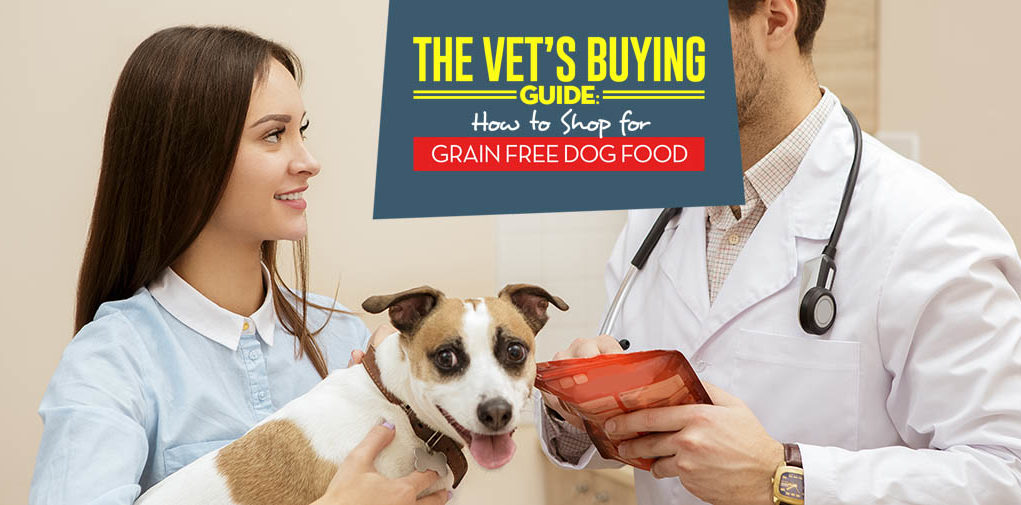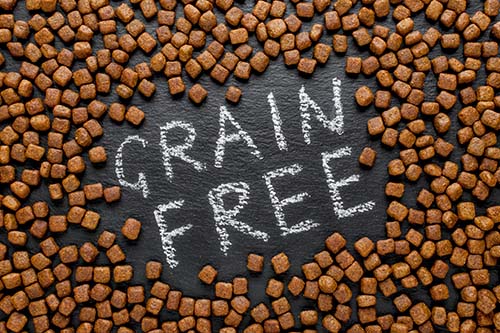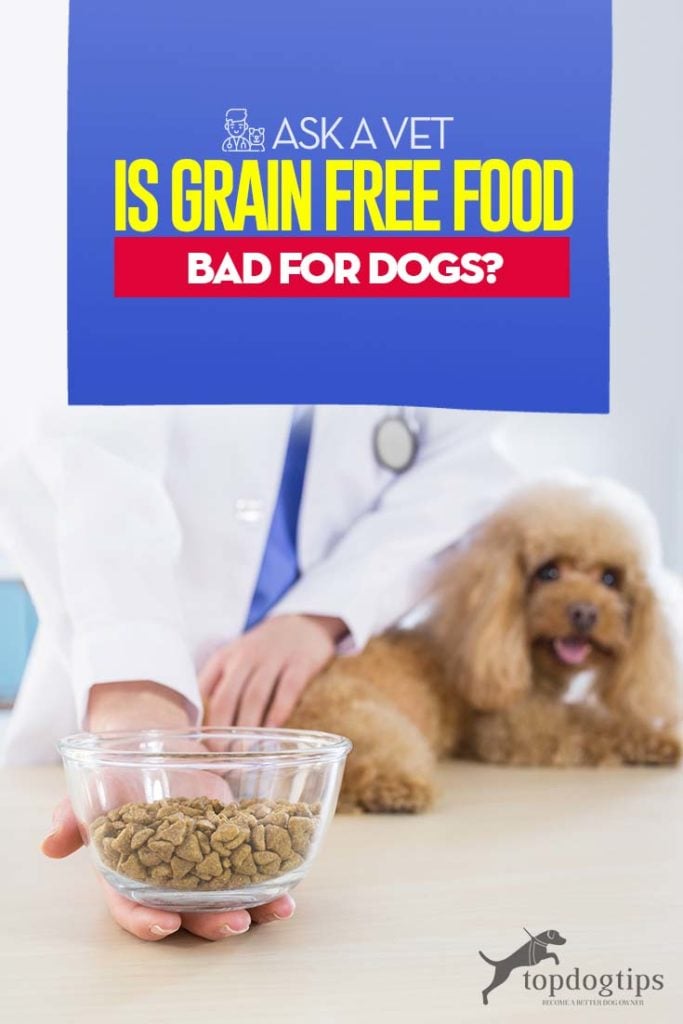Over the past decade, a grain-free diet for dogs has become all the rage for pet owners.
You've likely heard or read how no dog food should contain grains, and all this buzz may leave you wondering: is grain-free bad for dogs, or is it better?
Here's what science and vets say about this.
No Grains About It…
First, taking what's good for people and applying the same concepts to dogs isn't always the best approach for veterinary medicine and science.
Similarly, grain-free diets for dogs isn't always the right way.
This is how we came to FDA issuing warnings about grain-free food being bad for dogs and causing heart problems in pets.
This happened because, with the recent advent of ‘gluten-free', ‘grain-free', and ‘whole food' diet fads for humans, the grain-free diet for dogs has also taken off in the pet food market.
Many grain-free dog foods became popular, and a common thought process is, “well, if grains are bad for me, they must be bad for my dog… right?” or “grains are just added filler and have no reason to be in pet food, right?”
In my veterinary practice, I often hear the question, “is grain-free food bad for dogs or do you recommend it?”
In short, grain-free dog food has long been controversial with many experts, scientists, and veterinarians that follow an evidence-based approach.
Vets have been advising against grain-free foods for a long time but few pet owners listened, which resulted in these recent FDA warnings.
That said, the question of grains in dog food is a little more complicated than a simple “it's good” or “it's bad.”
Overall, it may be a suitable choice for some dogs but not necessary for most dogs.
We will also discuss why feeding grain-free dog food may not be the best option for your pooch.
ASK A VET: Does Hypoallergenic Dog Food Really Work and Why?
Is Grain-Free Food Bad for Dogs? (5 Reasons You May Want to Avoid It)
1. Food Fraud: It May Not Actually Be “Grain-Free”
Pet owners are often surprised that not all grain-free diets for dogs are actually, grain-free.
In order to understand how this is possible, you need to learn about food substances that are technically grains.
Merriam-Webster's online dictionary defines a grain in the following way (1):
- “a seed or fruit of a cereal grass”
- “the seeds or fruits of various food plants including the cereal grasses and in commercial and statutory usage other plants (such as the soybean)”
Botanically speaking, cereal grains belong to the family “Poaceae”, which includes wheat, corn, rice, oats, barley, sorghum, spelt, millet, triticale, rye, and many others.
Another group of “grains” has become popular in certain boutique dog foods and is often marketed as “grain-free” dog food diets.
They are technically correct, as ‘pseudo-grains' buckwheat, quinoa and amaranth are seeds – botanically speaking.
So why does this matter?
It matters because dog food companies may be lying to you, which shouldn't be a surprise at this point.
Pet food manufacturers rely on the fact that most people don't fully understand grain.
For example, most people think of wheat and corn when they think of ‘grains.'
Corn and wheat are currently the most ‘villainized' cereal grains, associated with GMO production, chemical residues, and poor health.
If you are committed to grain free dog food, be sure to read the labels carefully.
Sometimes rice or brewer's barley is in “gluten-free” or “grain-free” dog food diets.
These diets should be labeled “No Wheat, Soy or Corn” instead of simply grain-free dog food because rice is a grain.
Stick with reputable companies that are committed to a quality product.
If you're looking for recommendations for reputable dog food brands, do some research online or ask a canine nutritionist for assistance in choosing a product.
2. It's Not Necessarily Healthier for Dogs
First, let's start with a simple fact: no scientific evidence suggests that grain-free diets for dogs are a better option for every pet.
In fact, the research that has been done on these diets found somewhat opposite results. A 2014 study concludes:
“Labels that read ‘grain-free' are more harmful to the dog and should not be given unless required for other specific needs.”
Experts staying on top of current research on pet nutrition further confirm this, and generally disagree about switching your dog to a grain-free diet without a good reason to do so (see this, this, this, and this).
Potential link between grain-free dog food and dilated cardiomyopathy (DCM) in dogs
On top of that, there could be a link between grain free dog food and increased risk in heart disease.
Here's why that is important.
Your dog gets an important amino acid called taurine from their food because they cannot produce it on their own. This taurine deficiency affect your dog's heart health.
For example, in some dogs, there was an occurrence of dilated cardiomyopathy (dcm) and those dogs happened to have been fed a grain-free dog food.
This is dangerous because dilated cardiomyopathy can result in congestive heart failure.
In fact the occurrence spurred so much attention that there was an FDA investigation.
The FDA's investigation still is currently being funded and ongoing.
One could argue that you just get your dog on some taurine supplements and call it a day, but the verdict still remains in the balance.
Grain-free diets differ significantly one from another
Moreover, the grain-free diet for dogs has many variations, and they are not all created equally.
Unless he has a special health condition, grain free pet food shouldn't be “low-carb,” but many are.
On the other hand, grain-free dog foods that are high in protein and fat and low in carbs can be problematic for some dogs (2).
Studies show how feeding your dog grain-free may result in an imbalance of microorganisms in the dog's digestive tract, and if not immediately then eventually result in flatulence, diarrhea, vomiting, or constipation.
Some dogs that experience digestive upset or inconsistent stools on high-protein grain-free diets return to normal once you reintroduce grains or an appropriate high-fiber carbohydrate source.
To stick with a good balance of all macronutrients and fiber, look for pet foods that provide adequate amounts of fiber through ingredients like green peas, lentils, pumpkin, butternut squash, quinoa, apples, pears, and beet pulp.
Be careful of high-protein diets that contain only one or two sources of fiber.
Not all fiber is created equal, and different types affect the digestive system differently.
For example, Ziwi Peak's Air Dried Beef Formula is a grain-free dog food recipe and almost 100% meat.
It comes at 44% protein (high-protein) and 1% fiber on a dry matter basis.
This seems okay on the surface.
However, when you look at where that fiber is coming from in the ingredients list, it is from two sources – chicory root inulin (soluble fiber) and dried kelp (seaweed), a source of alginate fiber.
Both inulin and alginates from kelp are types of soluble fiber.
You should include insoluble and soluble fiber sources in your dog's diet.
Soluble fiber makes feces less bulky, feeds the “good” bacteria in the bowel, and binds water – making a “gel” that increases water in the feces (). It also makes speeds up fermentation by some bacteria, which can predispose dogs to flatulence if their diet only contains soluble fiber.
Meat-heavy diets containing only soluble fiber can also predispose some dogs to chronically loose stool or diarrhea, even over-stress the kidneys.
Insoluble fiber helps to normalize how quickly digested food moves through the digestive tract. It can help to speed things up or slow them down. They also make stools bulkier and a little drier.
Your dog's diet should contain both soluble and insoluble fiber sources. Check his diet for a combination of fiber sources, grain-free or not.
This will likely give the best balance of insoluble and soluble fiber.
If you see ingredients on the label from both sides of this chart, your dog's fiber is well-covered:
| Soluble Fiber Sources | Insoluble Fiber Sources |
| Inulin, chicory root | Whole Wheat |
| Seaweed, kelp | Oat Bran |
| Beet pulp | Whole Vegetables and Fruits or fruit skins |
| Whole Fruits | Flax |
| Whole Berries | Rye |
| Psyllium | Soybeans |
| Pectin | Peas, Lentils |
What the “normal” amount of fiber should be in a dog's diet is widely debated among experts.
Less than 5% dry matter fiber is typically recommended for adult dogs (4). Most commercial dog food diets are 1-2% fiber on a dry matter basis.
3. Dogs are Not Wolves
Many makers of products included in the grain-free diet for dogs promote their foods by claiming that your dog's ancestral DNA is common with the wolf.
This is true, but the comparison is flawed. After a strong scientific inquiry into how similar dogs of today are to wolves, the answer is – not very similar.
Yet pet owners often ask me, “wolves don't eat grains, so why should my dog?”
This comparison is flawed in that dogs are different from wolves and have evolved alongside humans for thousands of years.
Dogs are closer to indifferent omnivores, not true carnivores (5), and while wild dogs will hunt for fresh meat, they also get a large portion of their diet from scavenging.
Wild dogs today can and will eat leftover bread from a human garbage bin or half-rotten apples that have fallen from a tree.
Wolves typically don't.
Dogs evolved alongside humans and ate food for human consumption at times because of their scavenger nature, which included grains.
And 10,000 years of existing alongside humans is enough time to have the dog's digestive system to change and adapt to the new environment and diet, experts say.
Think about this: a similar comparison would be that humans share a lot of common DNA with chimpanzees, as we are all primates.
But, do humans have the same nutritional requirements as a chimp?
No.
We have evolved differently.
4. The Majority of Dogs Can Easily Digest Grains
As dogs have evolved alongside people, their digestive tracts can efficiently digest grain-based calories.
As I've mentioned, a grain-free diet for dogs can be a good option in very specific cases.
For example, if your pet has allergies, like grain allergies, switching to a grain-free dog food diet may seem like the way to go (and sometimes, it is).
Many people try gluten- or grain-free dog foods to alleviate certain symptoms.
While it's true that grain-free foods may help certain canines, it is unlikely to help your dog in the way that you think.
Most dogs with allergies suffer from atopic dermatitis.
Dogs can have itchy skin allergies to various substances, but dogs don't commonly suffer from gluten or grain intolerances or allergies. It is not impossible – but very unlikely.
Food causes only about 10% of dog allergies (6, 7, 8).
Most of this 10% is caused by eating proteins such as beef, chicken, eggs, and lamb, which studies have found to be the most common allergens.
While it does occur, wheat and corn are more rare causes of allergies in dogs.
Statistically, an allergy to something in the environment, such as pollen, mold, dust mite dander, and cockroach dander, most often causes your pet's itchy skin.
If you think your dog is suffering from a food allergy, please talk to your veterinarian.
Try a novel protein (venison, kangaroo) diet or a hypoallergenic diet before cutting out the grains, and put your pooch through the elimination diet trial.
5. The High Cost of Grain-Free Dog Foods
If nothing else, the last thing to mention about grain-free diets for dogs is their expensive price tag.
As you have probably seen, grain-free dog food typically costs more than its grain-containing counterparts, even between cheap dog food and top-rated dog foods.
Animal-based products are almost always more expensive pound-for-pound than plant-based products in pet foods.
Many dog food brands that are grain-free foods also include human-grade meats. While this can be healthier for our dogs, it also commands a higher price.
Whole fruits, vegetables, and even human-grade lentils in dog foods also increase in price.
I don't mean you shouldn't spend an extra dollar on your pet's food if you can afford it, but just be prepared before you make the switch.
6. Bonus: Grain free dog food typically use a poor-quality protein source.
Dog's need a high quality protein source like: chicken, beef, fish, eggs.
Many grain free dog foods typically formulate their recipe without a high quality protein.
For example, some of these companies use soy or the bulk of the recipe is sweet potatoes and other starches. This is basically using plant based protein. Which lacks the essential amino acid profile that meat provides.
These poorly formulated dog foods have been found to be linked to digestive disorders and other skin conditions.
Grain-Free Dog Food: In Conclusion
So is grain-free bad for dogs? In most cases, the answer is likely yes. A grain-free diet for dogs can be good only for certain pets and in specific cases.
In most instances, there is no need for your pet to eat a grain-free diet.
Moreover, studies have also found many cases where a grain-free diet can be worse for the dog than a grain-containing commercial food brand.
If you decide to switch to or from a grain-free dog food diet, remember to do so carefully. Anytime you change your dog's food, it is important to do so slowly.
Start by introducing 10% new food to 90% old food on Day 1, and by Day 7, you should be at 100% fresh food.
If your dog has a soft stool, diarrhea, or vomiting – go back to your old food for a few days and contact your veterinarian.
READ NEXT: 13 Dog Nutrition Tips That Are Actually Science-Based















